Shijie Geng
Lumina-T2X: Transforming Text into Any Modality, Resolution, and Duration via Flow-based Large Diffusion Transformers
May 09, 2024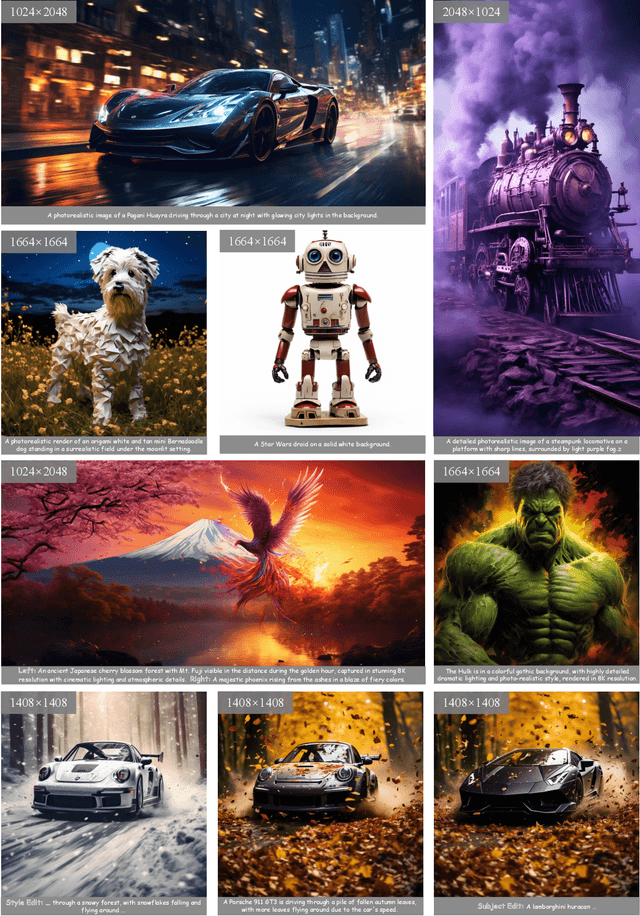

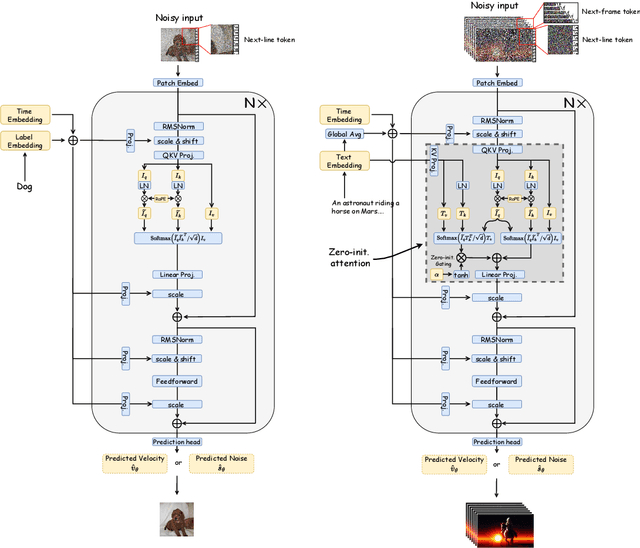
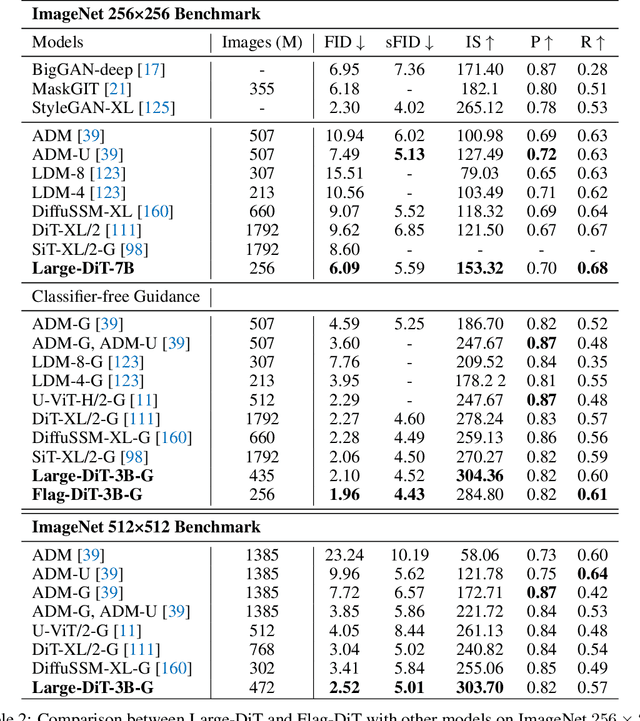
Abstract:Sora unveils the potential of scaling Diffusion Transformer for generating photorealistic images and videos at arbitrary resolutions, aspect ratios, and durations, yet it still lacks sufficient implementation details. In this technical report, we introduce the Lumina-T2X family - a series of Flow-based Large Diffusion Transformers (Flag-DiT) equipped with zero-initialized attention, as a unified framework designed to transform noise into images, videos, multi-view 3D objects, and audio clips conditioned on text instructions. By tokenizing the latent spatial-temporal space and incorporating learnable placeholders such as [nextline] and [nextframe] tokens, Lumina-T2X seamlessly unifies the representations of different modalities across various spatial-temporal resolutions. This unified approach enables training within a single framework for different modalities and allows for flexible generation of multimodal data at any resolution, aspect ratio, and length during inference. Advanced techniques like RoPE, RMSNorm, and flow matching enhance the stability, flexibility, and scalability of Flag-DiT, enabling models of Lumina-T2X to scale up to 7 billion parameters and extend the context window to 128K tokens. This is particularly beneficial for creating ultra-high-definition images with our Lumina-T2I model and long 720p videos with our Lumina-T2V model. Remarkably, Lumina-T2I, powered by a 5-billion-parameter Flag-DiT, requires only 35% of the training computational costs of a 600-million-parameter naive DiT. Our further comprehensive analysis underscores Lumina-T2X's preliminary capability in resolution extrapolation, high-resolution editing, generating consistent 3D views, and synthesizing videos with seamless transitions. We expect that the open-sourcing of Lumina-T2X will further foster creativity, transparency, and diversity in the generative AI community.
SPHINX-X: Scaling Data and Parameters for a Family of Multi-modal Large Language Models
Feb 08, 2024Abstract:We propose SPHINX-X, an extensive Multimodality Large Language Model (MLLM) series developed upon SPHINX. To improve the architecture and training efficiency, we modify the SPHINX framework by removing redundant visual encoders, bypassing fully-padded sub-images with skip tokens, and simplifying multi-stage training into a one-stage all-in-one paradigm. To fully unleash the potential of MLLMs, we assemble a comprehensive multi-domain and multimodal dataset covering publicly available resources in language, vision, and vision-language tasks. We further enrich this collection with our curated OCR intensive and Set-of-Mark datasets, extending the diversity and generality. By training over different base LLMs including TinyLlama1.1B, InternLM2-7B, LLaMA2-13B, and Mixtral8x7B, we obtain a spectrum of MLLMs that vary in parameter size and multilingual capabilities. Comprehensive benchmarking reveals a strong correlation between the multi-modal performance with the data and parameter scales. Code and models are released at https://github.com/Alpha-VLLM/LLaMA2-Accessory
Context-Aware Entity Grounding with Open-Vocabulary 3D Scene Graphs
Sep 27, 2023



Abstract:We present an Open-Vocabulary 3D Scene Graph (OVSG), a formal framework for grounding a variety of entities, such as object instances, agents, and regions, with free-form text-based queries. Unlike conventional semantic-based object localization approaches, our system facilitates context-aware entity localization, allowing for queries such as ``pick up a cup on a kitchen table" or ``navigate to a sofa on which someone is sitting". In contrast to existing research on 3D scene graphs, OVSG supports free-form text input and open-vocabulary querying. Through a series of comparative experiments using the ScanNet dataset and a self-collected dataset, we demonstrate that our proposed approach significantly surpasses the performance of previous semantic-based localization techniques. Moreover, we highlight the practical application of OVSG in real-world robot navigation and manipulation experiments.
VIP5: Towards Multimodal Foundation Models for Recommendation
May 23, 2023Abstract:Computer Vision (CV), Natural Language Processing (NLP), and Recommender Systems (RecSys) are three prominent AI applications that have traditionally developed independently, resulting in disparate modeling and engineering methodologies. This has impeded the ability for these fields to directly benefit from each other's advancements. With the increasing availability of multimodal data on the web, there is a growing need to consider various modalities when making recommendations for users. With the recent emergence of foundation models, large language models have emerged as a potential general-purpose interface for unifying different modalities and problem formulations. In light of this, we propose the development of a multimodal foundation model by considering both visual and textual modalities under the P5 recommendation paradigm (VIP5) to unify various modalities and recommendation tasks. This will enable the processing of vision, language, and personalization information in a shared architecture for improved recommendations. To achieve this, we introduce multimodal personalized prompts to accommodate multiple modalities under a shared format. Additionally, we propose a parameter-efficient training method for foundation models, which involves freezing the backbone and fine-tuning lightweight adapters, resulting in improved recommendation performance and increased efficiency in terms of training time and memory usage.
LLaMA-Adapter V2: Parameter-Efficient Visual Instruction Model
Apr 28, 2023



Abstract:How to efficiently transform large language models (LLMs) into instruction followers is recently a popular research direction, while training LLM for multi-modal reasoning remains less explored. Although the recent LLaMA-Adapter demonstrates the potential to handle visual inputs with LLMs, it still cannot generalize well to open-ended visual instructions and lags behind GPT-4. In this paper, we present LLaMA-Adapter V2, a parameter-efficient visual instruction model. Specifically, we first augment LLaMA-Adapter by unlocking more learnable parameters (e.g., norm, bias and scale), which distribute the instruction-following ability across the entire LLaMA model besides adapters. Secondly, we propose an early fusion strategy to feed visual tokens only into the early LLM layers, contributing to better visual knowledge incorporation. Thirdly, a joint training paradigm of image-text pairs and instruction-following data is introduced by optimizing disjoint groups of learnable parameters. This strategy effectively alleviates the interference between the two tasks of image-text alignment and instruction following and achieves strong multi-modal reasoning with only a small-scale image-text and instruction dataset. During inference, we incorporate additional expert models (e.g. captioning/OCR systems) into LLaMA-Adapter to further enhance its image understanding capability without incurring training costs. Compared to the original LLaMA-Adapter, our LLaMA-Adapter V2 can perform open-ended multi-modal instructions by merely introducing 14M parameters over LLaMA. The newly designed framework also exhibits stronger language-only instruction-following capabilities and even excels in chat interactions. Our code and models are available at https://github.com/ZrrSkywalker/LLaMA-Adapter.
Revisiting Multimodal Representation in Contrastive Learning: From Patch and Token Embeddings to Finite Discrete Tokens
Mar 27, 2023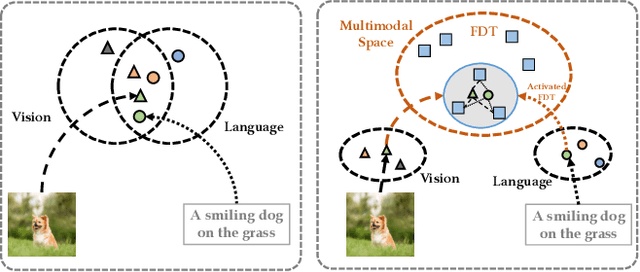



Abstract:Contrastive learning-based vision-language pre-training approaches, such as CLIP, have demonstrated great success in many vision-language tasks. These methods achieve cross-modal alignment by encoding a matched image-text pair with similar feature embeddings, which are generated by aggregating information from visual patches and language tokens. However, direct aligning cross-modal information using such representations is challenging, as visual patches and text tokens differ in semantic levels and granularities. To alleviate this issue, we propose a Finite Discrete Tokens (FDT) based multimodal representation. FDT is a set of learnable tokens representing certain visual-semantic concepts. Both images and texts are embedded using shared FDT by first grounding multimodal inputs to FDT space and then aggregating the activated FDT representations. The matched visual and semantic concepts are enforced to be represented by the same set of discrete tokens by a sparse activation constraint. As a result, the granularity gap between the two modalities is reduced. Through both quantitative and qualitative analyses, we demonstrate that using FDT representations in CLIP-style models improves cross-modal alignment and performance in visual recognition and vision-language downstream tasks. Furthermore, we show that our method can learn more comprehensive representations, and the learned FDT capture meaningful cross-modal correspondence, ranging from objects to actions and attributes.
HiCLIP: Contrastive Language-Image Pretraining with Hierarchy-aware Attention
Mar 06, 2023Abstract:The success of large-scale contrastive vision-language pretraining (CLIP) has benefited both visual recognition and multimodal content understanding. The concise design brings CLIP the advantage in inference efficiency against other vision-language models with heavier cross-attention fusion layers, making it a popular choice for a wide spectrum of downstream tasks. However, CLIP does not explicitly capture the hierarchical nature of high-level and fine-grained semantics conveyed in images and texts, which is arguably critical to vision-language understanding and reasoning. To this end, we equip both the visual and language branches in CLIP with hierarchy-aware attentions, namely Hierarchy-aware CLIP (HiCLIP), to progressively discover semantic hierarchies layer-by-layer from both images and texts in an unsupervised manner. As a result, such hierarchical aggregation significantly improves the cross-modal alignment. To demonstrate the advantages of HiCLIP, we conduct qualitative analysis on its unsupervised hierarchy induction during inference, as well as extensive quantitative experiments on both visual recognition and vision-language downstream tasks.
Mono-STAR: Mono-camera Scene-level Tracking and Reconstruction
Jan 30, 2023



Abstract:We present Mono-STAR, the first real-time 3D reconstruction system that simultaneously supports semantic fusion, fast motion tracking, non-rigid object deformation, and topological change under a unified framework. The proposed system solves a new optimization problem incorporating optical-flow-based 2D constraints to deal with fast motion and a novel semantic-aware deformation graph (SAD-graph) for handling topology change. We test the proposed system under various challenging scenes and demonstrate that it significantly outperforms existing state-of-the-art methods.
Frozen CLIP Models are Efficient Video Learners
Aug 06, 2022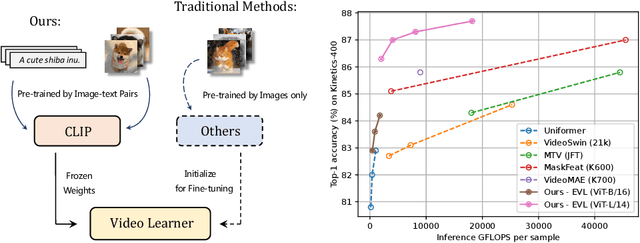
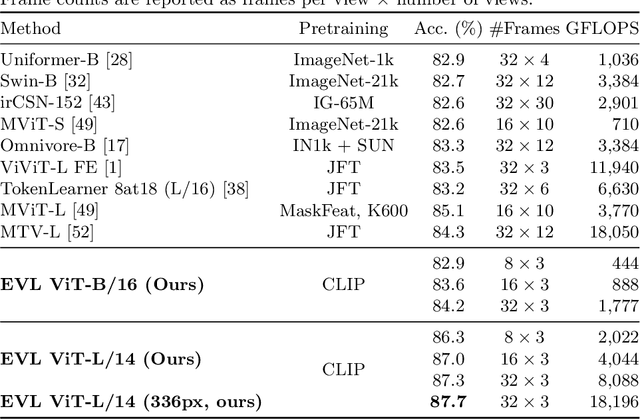
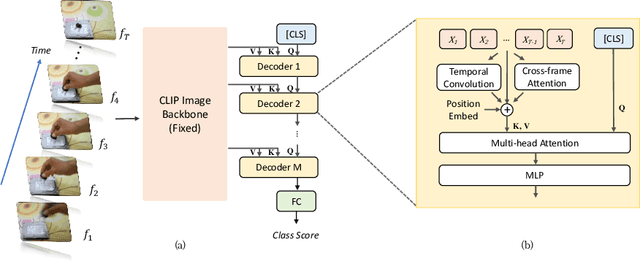
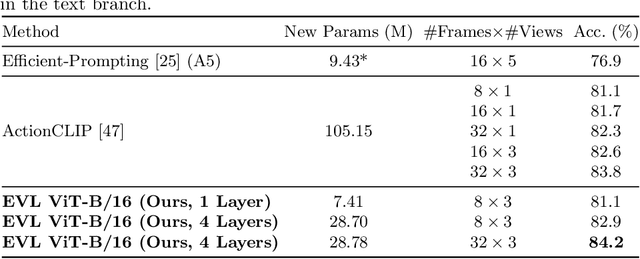
Abstract:Video recognition has been dominated by the end-to-end learning paradigm -- first initializing a video recognition model with weights of a pretrained image model and then conducting end-to-end training on videos. This enables the video network to benefit from the pretrained image model. However, this requires substantial computation and memory resources for finetuning on videos and the alternative of directly using pretrained image features without finetuning the image backbone leads to subpar results. Fortunately, recent advances in Contrastive Vision-Language Pre-training (CLIP) pave the way for a new route for visual recognition tasks. Pretrained on large open-vocabulary image-text pair data, these models learn powerful visual representations with rich semantics. In this paper, we present Efficient Video Learning (EVL) -- an efficient framework for directly training high-quality video recognition models with frozen CLIP features. Specifically, we employ a lightweight Transformer decoder and learn a query token to dynamically collect frame-level spatial features from the CLIP image encoder. Furthermore, we adopt a local temporal module in each decoder layer to discover temporal clues from adjacent frames and their attention maps. We show that despite being efficient to train with a frozen backbone, our models learn high quality video representations on a variety of video recognition datasets. Code is available at https://github.com/OpenGVLab/efficient-video-recognition.
Hierarchically Self-Supervised Transformer for Human Skeleton Representation Learning
Jul 20, 2022
Abstract:Despite the success of fully-supervised human skeleton sequence modeling, utilizing self-supervised pre-training for skeleton sequence representation learning has been an active field because acquiring task-specific skeleton annotations at large scales is difficult. Recent studies focus on learning video-level temporal and discriminative information using contrastive learning, but overlook the hierarchical spatial-temporal nature of human skeletons. Different from such superficial supervision at the video level, we propose a self-supervised hierarchical pre-training scheme incorporated into a hierarchical Transformer-based skeleton sequence encoder (Hi-TRS), to explicitly capture spatial, short-term, and long-term temporal dependencies at frame, clip, and video levels, respectively. To evaluate the proposed self-supervised pre-training scheme with Hi-TRS, we conduct extensive experiments covering three skeleton-based downstream tasks including action recognition, action detection, and motion prediction. Under both supervised and semi-supervised evaluation protocols, our method achieves the state-of-the-art performance. Additionally, we demonstrate that the prior knowledge learned by our model in the pre-training stage has strong transfer capability for different downstream tasks.
 Add to Chrome
Add to Chrome Add to Firefox
Add to Firefox Add to Edge
Add to Edge